How does North Korea track its long-distance missile tests?
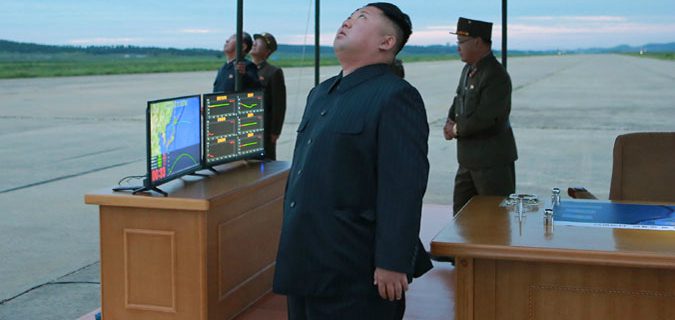
North Korea faces significant hurdles to collect real-time telemetry from long-distance missile tests
North Korea’s two most recent intermediate range missile tests, which both involved the newly developed Hwasong-12 intermediate-range ballistic missiles (IRBM), demonstrated an ever-improving capability to reach targets far, far away from the peninsula.
The August 28 Hwasong-12 launch resulted in splashdown 2,700km from launch, while the September 14 test-fire resulted in a splashdown some 3,400km from Pyongyang – the furthest-ever North Korean ballistic missile test in history – excluding satellite launch attempts.
Pictured observing the two tests from a runway at Pyongyang’s Sunan International Airport, Kim Jong Un was shown in official state media in both cases with computer monitors in the background, rendering charts detailing in-flight missile test performance data and maps of the splashdown points east of Japan.
But while similar screens depicting missile flight data have been observed behind Kim Jong Un during other test events of the past few years, these two Hwasong-12 tests involved splashdown points much further away from the launch-pads than anything seen before from North Korea.
And North Korea’s two Hwasong-14 intercontinental ballistic missile (ICBM) tests of July 4 and July 28, though both intentionally fired on “lofted” short-distance but high altitude trajectories, will be required to travel many thousands of kilometers further than the Hwasong-12 tests if they are ever to be tested on a full-distance trajectory.
But the technical challenges involved in obtaining real-time data of missile tests that go so far from home are formidable, raising major questions about just how North Korean engineers are able to reliably track performance indicators related to the terminal flight phase, warhead re-entry, and splashdown location.
And that’s important, because amid growing anticipation of a future North Korean long-distance ICBM test – possibly far into the southeast Pacific Ocean – some of the technologies required for accurate remote data collection could provide the international community with leading indicators of the time and trajectory of potential future tests.
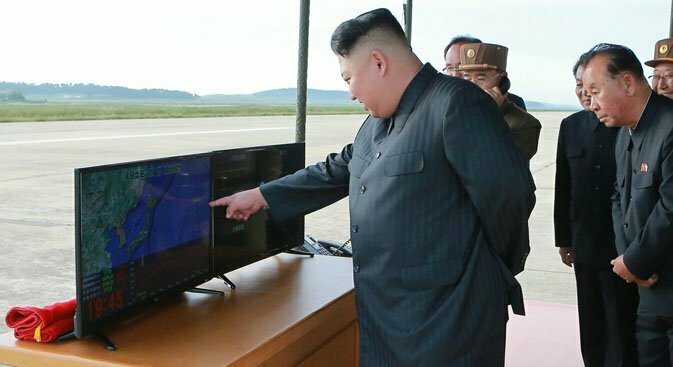
Kim Jong Un observes telemetry data at Pyongyang’s Sunan airport | Picture: Rodong Sinmun
MISSILE PERFORMANCE DATA
When countries test missiles, it is important for engineers to be able to collect as much performance data about the launch as possible. But while some of this data can be collected relatively easily from cameras, antennae and radar equipment positioned near the launch-pad, the further the missile flies away, the harder it becomes to remotely receive flight data in real-time.
“In this age of GPS (tracking) – or GLONASS or Galileo – the (missile) re-entry vehicle knows its position at any time during the flight, including the point of splashdown,” says Uzi Rubin, former director of Israel’s missile defense program.
“(But) this information remains unknown to the missile’s owners, unless it can be recovered either by telemetry or metry.”
The technical challenges involved in obtaining real-time data of missile tests that go so far from home are formidable
In order for a country to receive flight data of a missile launch and subsequent flight in real-time, a telemetry system is required to remotely receive and record performance measurement indicators transmitted from an instrumented warhead.
But the locations of telemetry receiving stations at land, sea or air, play a large role in determining exactly how much data can be received, especially with longer-distance missile tests that travel to locations far beyond the visible horizon.
“One must deploy telemetry receiving devices (antennae and receivers) beyond the horizon and within a line of sight with the missile,” says Rubin. “To get the data at the moment of splashdown, the receiving system must be quite close by.”
As a result, countries testing missiles far away often “use instrumented ships or aircraft to obtain beyond-the-horizon data,” Rubin continues, a point relevant, he says, “not only to the reentry and splashdown data, but to all telemetry data in the beyond the horizon portion of the trajectory.”
An alternative, metry-only approach to collecting data also exists, however.
Countries testing missiles which don’t have sufficient remote data-receiving equipment positioned along the intended flight path can otherwise collect data after splashdown. An instrumented warhead can record performance indicators in an onboard black box-style unit that can subsequently be recovered.
But “this is not always feasible and anyway requires a visit of some recovery ship in the splashdown area,” says Rubin.
That said, it’s not impossible.
“For actual practical ocean recovery (if the missile is equipped with recoverable parts, like a black box/telemetry cassette), the recoveries I’m familiar with would release brightly colored dyes to help sailors determine its exact location,” says Scott Lafoy, an NK Pro analyst with expertise in missile programs.
“Scientists/engineers crunch the numbers ahead of time to establish where the missile should generally impact or reenter…then dyes or beacons help sailors find the recoverable pieces,” he says, enabling ships to proactively sail out to probably splashdown locations and then find the metry recorders more easily.
But given the distances missiles like an ICBM or IRBM can travel, sending ships to collect data recordings at the bottom of deep oceans can be no easy feat. “Think about recoveries of airliners’ black boxes following flight disasters,” Rubin points out.
An even more rudimentary option exists if the aim is to simply detect whether or not a missile warhead has re-entered within the intended target area, by deploying “one or more assets in the planned impact area that have eyes on the reentry and impact,” according to Nick Hansen, a retired expert on imagery technology and electronic systems laboratory at Stanford University.
The deployment of such assets would – in principle – allow for visual confirmation of whether or not the missile warhead arrived.
“(But) there are obvious drawbacks to this option, including bad weather and line of sight,” Hansen says. “You either see it or you don’t and if you see something you know it is in the impact area, but have no idea if it worked the way it was planned.”
As such, while “it is better than nothing,” it appears that limited visual performance indicator data is unlikely to provide sufficient data for most international missile engineers.
That’s because “telemetry is essential for development launches, for various reasons,” according to Markus Schiller, a missile engineer based in Germany who regularly analyzes North Korean missile tests.
“You want to know how the missile operates during boost phase, but also what might have gone wrong if the missile explodes…” he says.
“Getting an idea of what actually went wrong without having live telemetry is almost impossible because not much will be left from the missile once it explodes.”
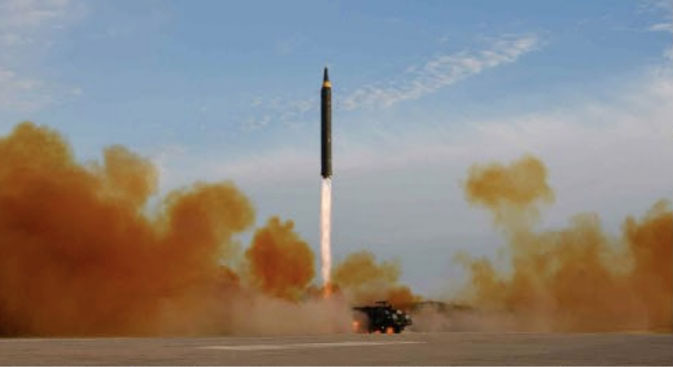
Hwasong-12 IRBM launch at Sunan airport | Picture: Rodong Sinmun
HOW DOES NORTH KOREA DO IT?
It’s North Korea’s collection of missile performance data in real-time via telemetry all the way out to splash-down points thousands of kilometers away in the Pacific that is so difficult for missile researchers to understand.
“How do they receive the data and (flight) video shown on the two or three computer screens that always are on a table adjacent to the desk Kim for all the launches he directs?” asks Hansen.
“Those monitors display launch video from ground cameras, and telemetry showing missile parameters, tacking data and onboard video during flight,” he says. “They continue to display data and video throughout the flight.”
Video of North Korea’s recent tests demonstrates that a working telemetry system appears to be in place, rather than a post-splashdown collection of data from recovered flight recorders after launch.
State media, for example, regularly splice ground footage of the launch event with video apparently received in real-time from cameras mounted on the body of the missile as it flies high into the atmosphere and away from the NE Asia region.
Missiles launched on high-altitude ‘lofted’ trajectories from North Korea, as has mostly been the case in recent years, might lend themselves to a type of real-time, but limited, telemetry collection capability.
Video of North Korea’s recent tests demonstrates that a working telemetry system appears to be in place
“While a missile is flying on a very high, lofted trajectory, North Korea could track it via radar when there is line of sight with the missile,” says Tal Inbar, head of the Space & UAV center at the Fisher Institute for Air and Space Strategic Studies.
But for those missiles landing hundreds or thousands of kilometers from the peninsula, “they might use optical tracking and perhaps radars on a ship,” Inbar adds. “But these ships are hypothetical as there is no concrete information on their existence and deployment.”
And crucially, if the telemetry receivers are “located in North Korea, they will not receive any telemetry broadcast from the missile once it is below the horizon,” says Hansen.
Therefore, “if you want to get telemetry data beyond visual range from the launch site,” says Schiller, the German missile engineer, “you need additional telemetry sites, of course, or ships with that capacity, or relay satellites.”
For those missiles being tested far east of the Japanese mainland, like the Hwasong-12 in September, or in the case of a future long-distance ICBM test, North Korea’s options for reliably collecting telemetry become limited.
“The Pacific Ocean is a big area when you launch a warhead 5000 to 10,000km,” says Hansen. “This is outside the range of the North’s aircraft and most of their ships.”’
However, historical ship tracking data rendered via a heat map function on the NK Pro Ship Tracker shows that some vessels owned or linked to the DPRK have indeed crossed the Pacific Ocean in the past, proving it’s not inconceivable that Pyongyang could get assets in place far from the peninsula to collect missile telemetry.
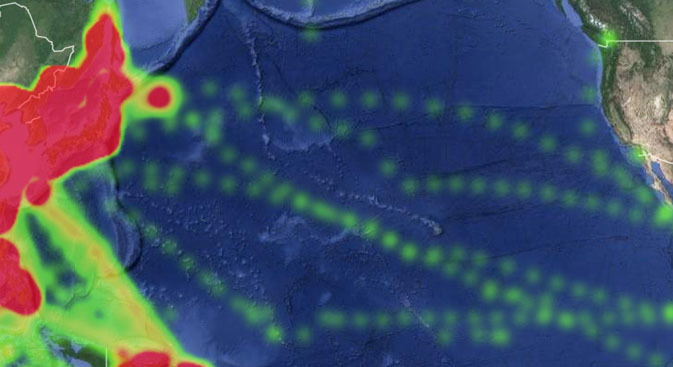
NK Pro Ship Tracker data shows several cross-Pacific sailings since 2013 | Picture: NK Pro / Google Earth
“A large civil merchant ship would seem the best candidate to mount telemetry equipment on,” continues Hansen. “We know that at least one of their ships carried missile parts to be repaired from Cuba to the North, as they got caught in Panama.”
And the North may have even already developed some experience in using ships to collect telemetry data from far away, at least with data transmitted on either the Very High Frequency (VHF) or Ultra High Frequency (UHF) bands, which require simple antennas to work with.
Some vessels owned or linked to the DPRK have indeed crossed the Pacific Ocean in the past
“It is suspected for the 1998 Tapodong-1 launch they used VHF telemetry on a van and had a naval ship in the Pacific to monitor the third stage and satellite separation event,” Hansen says.
In the event of a long-distance North Korean ICBM test, then, “a ship monitoring telemetry in the impact (area) is probably the most likely means they would use.”
Such a vessel would have the benefit of being able to report a visual sighting back to headquarters on “high frequency radio, an aircraft relay, or on a satellite link,” Hansen says. “Analysis of the collected telemetry would probably take place when the ship returns to port.”
And “there are ways to plan ship transits to be in or near the impact area on the day of launch,” he continues.
However, sending ships far out to see is also a risk for the North. Not only could such vessels be intercepted by enemies, but their slow movement into open ocean could provide useful intelligence to enemies about the potential direction and timing of future DPRK missile testing.
“It seems unlikely to me that North Korean vessels would be allowed to operate in impact areas without being trailed (or searched?) by international naval forces,” says Schiller.
“And it also seems unlikely that a data recorder would survive impact for one thing, and if it does, to send signals that are only used by North Korean vessels to track the recorder down and recover it – I think ROK or U.S. vessels would be quicker.”
As a result, to minimize chances of detection, “they’d have to be sneaky with telemetry ships, possibly disguising them as cargo ships or keeping them away from populated areas,” says Lafoy, the NK Pro analyst.
“It is also worth nothing that telemetry ships get pretty big,” Lafoy points out. “It is possible to create small ones, but the DPRK is not known for its radar and tracking capabilities – their at-sea telemetry capabilities seem fairly underdeveloped.”
However, Israeli missile engineer Uzi Rubin says the North could “use commercial freighters covertly instrumented – this can be done by hiding the instruments in containers – or another nation’s instrumented ships, overt or coverts.
“(But) in any case, some vessel… must be present in the neighborhood of the impact point or visit the area soon after the test.”
Despite all the challenges, Hansen says it’s possible the North might, however, even get away with a long-distance ship movement undetected.
“If they turn off the ships AIS beacon for a day or two there is little chance they would be found and there would be no way to prove they were part of the test: remember the North does not send out notices to mariners for their tests.”
That said, Chinese precedence could suggest otherwise.
“In preparation for the first Chinese DF-5 ICBM full-range test, the PRC sent 18 ships to the impact zones over 2 weeks ahead of time,” says Lafoy.
“It was an enormous endeavor that was really visible to the U.S. intelligence community, based on declassified reports. “There were months of preparation put into the rocket launch, including the delivery and installation of new telemetry equipment at various points.”
ALTERNATIVES
Following the rapid emergence of accidental Japanese CCTV video recordings of the re-entry of North Korea’s September 14 IRBM test, it was speculated in some circles that Pyongyang, absent having its own telemetry receiving equipment nearby, might in some cases just rely on outside data to learn about missile performance far from home.
“There is an alternative scenario where they aren’t doing a test ‘the right way’,” says Lafoy. “Instead of actually trying to gather valuable technical data, if the point is purely for deterrence and showmanship, no ships would be needed at all.”
In such a case, the North could just “wait until it gets reported by the U.S., ROK or Japan and they get the impact information second-hand,” Hansen says.
Alternatively, “as long as it goes far enough for Kim to declare a success and put out a propaganda video it is a success,” Hansen continues. “(Such an approach) means they put a lot of faith in the tests that have lofted trajectories and the burn-in tests done on a test stand, with a rocket engine blasting the warhead.”
The North might, however, even get away with a long-distance ship movement undetected
And “if they are happy… with measuring the cutoff position, they do not need telemetry,” Schiller, the German engineer, adds, referring to the location at which ground-based receivers would lose contact with a long-distance missile test.
“But that way, you cannot develop new missiles; you can only figure out how precise your operational missiles are being launched by your launch crews.”
One other option does, however, exist, but specialists told NK Pro it would be very unlikely for the North.
“In theory, a satellite could be part of the effort to receive information from a missile during test launch,” says Tal Inbar, of the Fisher Institute. “However, there is no indication that the North Korean satellites currently in orbit are capable to do this.”
And while North Korea claims to have launched multiple satellites successfully, Hansen says they were “dead on arrival after injection into orbit,” with both tumbling and unable to expand solar panels to generate the necessary electricity for communications.
“Even if they were working and had sensors on board that could receive the telemetry signal, they are in low earth orbits (LEO) so the only see the same area of the ocean for about six minutes twice a day,” Hansen says.
“That would require very accurate timing to have a satellite in position when the warhead reenters and impacts and pointed in the right direction.”
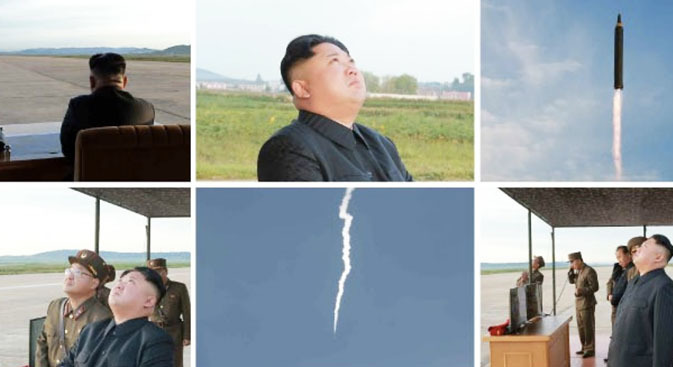
Missile test photos | Picture: Rodong Sinmun
CONCLUSIONS
Understanding how – or if – North Korea collects telemetry from long-distance missile tests remains an open question, but one that if accurately answered could provide significant clues for determining the potential reliability of its emerging missile designs and even for estimating the timing and location of potential future tests.
Looking at a recent case, Hansen says he believes the video monitors seen rendering missile flight performance data behind Kim Jong Un weren’t just fake or only there to depict a simulated trajectory of the planned launch mission.
In particular, citing the September 14 Hwasong-12 test over Japan, Hansen points out that “a four element VHF/UHF telemetry was seen on the runway during the launch.”
“It was pointed at about a 42-degree elevation angle to the east just after launch, (and) in the foreground Kim and several of his generals were looking in the same direction at the missile,” he says.
“This is probably how the onboard telemetry is received during prelaunch, launch and until the missile goes out of sight.”
But how data is collected beyond that cut-off point remains a mystery – for now.
The splash-down locations of the North’s longest distance tests make it impossible for DPRK aircraft to be positioned in the right areas to collect data at the time of impact, being far out of range.
Satellite collection of the data also appears extremely unlikely in the North Korean case, given the orbits the DPRK’s satellites are currently on and the fact they are not apparently even working.
It’s possible, therefore, that North Korea uses ships positioned far out at sea to receive launch data near splash-down in real-time, or that ships might even sail out to collect recorded data following the test event.
However, both methods leave such ships open to interception or tracking by enemies more eager and capable of collecting the data before the North can.
As such, it’s also possible that the North might just be leaving long-distance data collection to others, via what’s reported by the Japanese, South Koreans and U.S., all of whom have much more capable and far-sighted equipment.
This would come, however, at the expense of North Korea’s own engineers being able to obtain reliable and real-time data to understand just how well new designs perform, and deprive Pyongyang of possibly valuable propaganda footage of a successful warhead detonation far from DPRK territory.
Edited by Oliver Hotham
Main picture: Rodong Sinmun
About the Author
CHAD O’CARROLL
Chad O’Carroll has written on North Korea since 2010 and writes between London and Seoul
Source:.nknews.org
